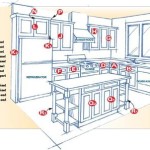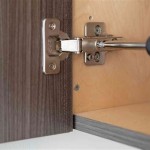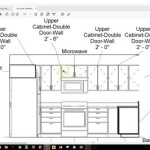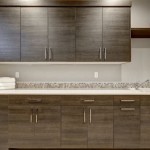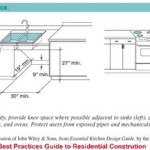Standard Size of Kitchen Drawers: A Comprehensive Guide
Kitchen drawers are fundamental components of kitchen cabinetry, providing essential storage for utensils, cookware, cutlery, and various kitchen essentials. Understanding standard drawer sizes is critical for effective kitchen design, ensuring functionality, accessibility, and aesthetic appeal. This article delves into the common dimensions of kitchen drawers, factors influencing size selection, and considerations for optimizing drawer space.
The term "standard" in cabinetry refers to common, readily available sizes and dimensions that manufacturers produce and designers frequently incorporate. While complete standardization across the industry isn't absolute, a generally accepted range of sizes exists for kitchen drawers in terms of width, depth, and height. Deviations from these "standard" sizes are possible and often necessary to accommodate specific design requirements or custom installations. However, familiarity with the typical measurements serves as a valuable starting point for any kitchen renovation or construction project.
Understanding Kitchen Drawer Dimensions
Kitchen drawers are generally described using three primary measurements: width, depth, and height. The width refers to the horizontal measurement from side to side, the depth refers to the measurement from the front of the drawer to the back, and the height refers to the vertical measurement from the bottom of the drawer box to the top.
Width: Standard kitchen drawer widths typically range from 12 inches to 36 inches, increasing in increments of 3 inches. Common widths include 12", 15", 18", 21", 24", 27", 30", 33", and 36". The chosen width often depends on the overall cabinet layout, the intended purpose of the drawer, and available space. Wider drawers are often used for storing larger items like pots and pans, while narrower drawers are suitable for utensils and cutlery.
Depth: The depth of a kitchen drawer is usually determined by the depth of the base cabinet. Most base cabinets have a standard depth of 24 inches. As such, drawer depths often fall within the range of 20 to 22 inches to allow for clearance behind the drawer and the installation of drawer slides. Depth can sometimes be variable, especially in custom cabinetry, but a shallower drawer will reduce usable storing space.
Height: Drawer height varies more significantly than width or depth, as it is directly related to the drawer's intended function. Shallow drawers, often referred to as "utility drawers," might be only 3 to 4 inches high, ideal for storing silverware or spice jars. Medium-height drawers, ranging from 5 to 7 inches, are suitable for storing utensils, smaller cooking tools, or wrapped food items. Deep drawers, measuring 8 inches or more in height, are typically used for storing pots, pans, lids, and other bulky items.
It's important to note that these dimensions are the *exterior* dimensions of the drawer box. The interior usable space will be slightly smaller due to the thickness of the drawer box material (typically ½" to ¾") and the space occupied by the drawer slides.
Factors Influencing Drawer Size Selection
Several factors influence the selection of appropriate drawer sizes for a kitchen design project. A well-planned drawer configuration takes these factors into account to maximize storage efficiency and user convenience.
Available Space and Cabinet Configuration: The layout of the kitchen and the configuration of the base cabinets are primary determinants of drawer size. The overall size of the kitchen, the placement of appliances, and the location of doorways and windows all impact the available space for cabinetry. Careful planning of cabinet placement is crucial to optimize drawer sizing and placement.
Intended Use and Storage Needs: The intended use of each drawer directly influences its optimal size. For example, a drawer intended for storing pots and pans will require a larger width and height than a drawer designed for cutlery. Accurately assessing storage needs is essential for selecting the right drawer sizes. Create an inventory of the items that will be stored in drawers, noting their dimensions and quantity. Group like items together and determine the approximate drawer space needed for each category.
Ergonomics and Accessibility: Ergonomics plays a significant role in kitchen design. Drawer placement and accessibility should be carefully considered. Frequently used items should be stored in easily accessible drawers, ideally located between waist and shoulder height. Deep drawers, especially those storing heavy items, should be located lower in the base cabinets to minimize bending and lifting. Consider the ease of opening and closing drawers, particularly in busy areas of the kitchen. Soft-close drawer slides are a popular option that enhances user experience and prevents slamming.
Aesthetic Considerations: While functionality is paramount, aesthetics also play a role in drawer size selection. Maintaining visual balance and symmetry in the kitchen design is important. Consider the overall proportions of the cabinets and drawers and how they relate to other design elements in the space. Consistent drawer front styles and finishes can create a cohesive and visually appealing look.
Budget: Custom drawer sizes and configurations often come with a higher price tag than standard options. Establishing a realistic budget early in the design process is essential. Explore options for incorporating standard-sized drawers while still meeting specific storage needs. Prioritize custom sizes for drawers where they are most critical and opt for standard sizes for less critical areas.
Optimizing Drawer Space and Organization
Even with carefully selected drawer sizes, efficient organization is key to maximizing storage capacity. Implementing various organizational tools and strategies can significantly improve drawer functionality and accessibility.
Drawer Dividers and Inserts: Drawer dividers and inserts are valuable tools for organizing drawers and preventing items from shifting and cluttering. Adjustable dividers allow for customizing the drawer layout to accommodate different items. Cutlery trays, spice racks, and knife blocks are examples of specialized inserts that optimize storage for specific items. Consider using clear acrylic or solid wood dividers for a more aesthetically pleasing look.
Vertical Organizers: Vertical organizers are particularly useful for maximizing space in deep drawers. These organizers allow for stacking items vertically, creating more storage capacity. Pot and pan organizers, lid organizers, and cutting board organizers are examples of vertical organizers that can significantly improve drawer efficiency. These organizers also make it easier to locate and access items without having to rummage through a pile of cookware.
Roll-Out Trays: Roll-out trays, also known as pull-out shelves, can be installed inside cabinets or drawers to improve accessibility. These trays allow for easy access to items stored in the back of the cabinet or drawer, eliminating the need to reach and bend awkwardly. Roll-out trays are particularly useful for storing frequently used items like pantry staples or heavy cookware. The installation of roll-out trays in deep drawers can also provide better visibility and organization.
Custom Drawer Organizers: For highly specific storage needs, consider custom drawer organizers. These organizers can be designed and built to perfectly fit the drawer dimensions and the items being stored. Custom organizers are particularly useful for storing specialized tools, collectibles, or oddly shaped items. Collaborate with a cabinet maker or custom storage specialist to design and fabricate custom drawer organizers that meet specific requirements.
Proper Labeling: Labeling drawers can help ensure that items are stored in their designated locations and that drawers are not overfilled. Clear and consistent labeling also makes it easier for all household members to find and retrieve items. Use label makers, adhesive labels, or even hand-written labels to identify the contents of each drawer.
Regular Decluttering: Regular decluttering is essential for maintaining an organized kitchen. Periodically review the contents of drawers and remove items that are no longer needed or used. Donate or dispose of unwanted items to free up space and prevent clutter. A well-organized kitchen is a functional and efficient kitchen, and regular decluttering is key to maintaining its order.
Ultimately, selecting the optimal size of kitchen drawers requires considering numerous factors and implementing organizational strategies. While standard drawer sizes provide a useful starting point, customization is often necessary to achieve a truly functional and visually appealing kitchen design.

Cabinet Sizes Blok Designs Ltd

Kitchen Cabinet Drawer Dimensions Standard Inspiration Ideas 3 Decorating Cabinets Height Measurements

Image Result For Kitchen Drawer Size Drawers Cabinet Dimensions

Cabinet Sizes Blok Designs Ltd

View Topic Show Your Walk In Pantry Home Renovation Building Forum Kitchen Cabinet Drawers Base Cabinets

Proper Depth For Frameless Cabinets

Cabinet Face Dimensions

N Standard Kitchen Dimensions Renomart

Kitchen Unit Door Combinations
-8197-p.jpg?strip=all)
Pine Traditional Style Ascending 3 Drawer Kitchen Base Unit 600mm
Related Posts

